Delahaye
Delahaye automobile was an automotive manufacturing company founded by Émile Delahaye in 1894, in Tours, France, his home town. His first cars were belt-driven, with single- or twin-cylinder engines mounted at the rear. His Type One was an instant success, and he urgently needed investment capital and a larger manufacturing facility. Both were provided by a new Delahaye owner and fellow racer, George Morane, and his brother-in-law Leon Desmarais, who partnered with Émile in the incorporation of the new automotive company, "Societe Des Automobiles Delahaye", in 1898. All three worked with the foundry workers to assemble the new machines, but middle-aged Émile was not in good health.
| Industry | Manufacturing |
|---|---|
| Founded | 1894 |
| Founder | Émile Delahaye |
| Defunct | 1954 |
| Headquarters | Tours (France) |
| Products | Cars |
| Website | www |
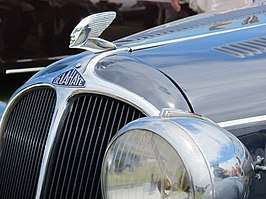
In January 1901, he found himself unable to capably continue, and resigned, selling his shares to his two equal partners. Émile Delahaye died soon after, in 1905. Delahaye had hired two instrumental men, Charles Weiffenbach and Amédée Varlet in 1898, to assist the three partners.[1] Both were graduate mechanical engineers, and they remained with Delahaye their entire working careers. Weiffenbach was appointed Manager of Operations, and, with the blessing of both George Morane and Leon Desmarais, assumed control over all of Delahaye's operations and much of its decision-making, in 1906.
Amédée Varlet was the company's design-engineer, with a number of innovative inventions to his credit, generated between 1905 and 1914, which Delahaye patented. These included the twin-cam multi-valve engine, and the V6 configuration. Varlet continued in this role until he eventually took over the Drawing Office, at 76 years of age, when much younger Jean François was hired in 1932 as chief design-engineer. In 1932, Varlet was instructed by Weiffenbach, under direction from majority shareholder Madame Desmarais, Leon Desmarais' widow, to set up the company's Racing Department, assisted by Jean François. Those who knew him well at the factory affectionately referred to Charles Weiffenbach as "Monsieur Charles".
History
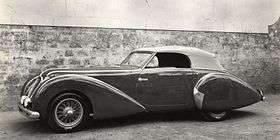
Delahaye began experimenting with belt-driven cars while manager of the Brethon Foundry and Machine-works in Tours, in 1894.[2] These experiments encouraged an entry in the 1896 Paris–Marseille–Paris race, held between 24 September-3 October 1896, fielding one car for himself and one for sportsman Ernest Archdeacon.[3] The winning Panhard averaged 15.7 mph (25.3 km/h); Archdeacon came sixth, averaging 14 mph (23 km/h), while Delahaye himself was eighth, averaging 12.5 mph (20.1 km/h).[3]
For the 1897 Paris-Dieppe, the 6 hp (4.5 kW; 6.1 PS) four-cylinder[4] Delahayes ran in four- and six-seater classes, with a full complement of passengers. Archdeacon was third in the four-seaters behind a De Dion-Bouton and a Panhard, Courtois winning the six-seater class, ahead of the only other car in the class.[3]
In March 1898, 6 hp (4.5 kW; 6.1 PS) the Delahayes of Georges Morane and Courtois came sixteenth and twenty-eighth at the Marseilles-Nice rally, while at the Course de Perigeux in May, De Solages finished sixth in a field of ten.[3] The July Paris-Amsterdam-Paris earned a satisfying class win for Giver in his Delahaye; the overall win went to Panhard.[3]
Soon after the new company was formed in 1898, the firm moved its manufacturing from Tours to Paris, into its new factory (a former hydraulic machinery plant that Morane and his brother-in-law Leon Desmarais had inherited from Morane's father). Charles Weiffenbach was named Operations Manager.[3] Delahaye would produce three models there, until the close of the 19th century: two twins, the 2.2-litre 4.5 hp (3.4 kW; 4.6 PS) Type 1 and 6 hp (4.5 kW; 6.1 PS) Type 2, and the lighter Type 0 (which proved capable of up to 22 mph (35 km/h)), with a 1.4-liter single rated between 5 and 7 hp (3.7 and 5.2 kW; 5.1 and 7.1 PS).[5] All three had bicycle-style steering, water-cooled engines mounted in the rear, automatic valves, surface carburetors, and trembler coil ignition; drive was a combination of belt and chain, with three forward speeds and one reverse.[5]
In 1899, Archdeacon piloted an 8 hp (6.0 kW; 8.1 PS) racer in the Nice-Castellane-Nice rally, coming eighth, while teammate Buissot's 8 hp (6.0 kW; 8.1 PS) was twelfth.[5]
Founder Émile Delahaye retired in 1901, leaving Desmarais and Morane in control; Weiffenbach took over from them in 1906.[5] Delahaye's racing days were over with Émile Delahaye's death. Charles Weiffenbach had no interest in racing, and focused his production on responsible motorized automotive chassis, heavy commercial vehicles, and early firetrucks for the French government. Race-cars had become a thing of the past for Delahaye, until 1933, when Madame Desmarais caused her company to change direction 180 degrees, and return to racing.
The new 10B debuted in 1902.[5] It had a 2,199 cc (134.2 cu in) (100 by 140 mm (3.9 by 5.5 in)) vertical twin rated 12/14 hp by RAC, mounted in front, with removable cylinder head, steering wheel (rather than bicycle handles or tiller), and chain drive.[5] Delahaye also entered the Paris-Vienna rally with a 16 hp (12 kW; 16 PS) four; Pirmez was thirty-seventh in the voiturette class. At the same year's Ardennes event, Perrin's 16 hp (12 kW; 16 PS) four came tenth.[5]
Also in 1902, the singles and twins ceased to be offered except as light vans; before production ceased in 1904, about 850 had been built.[5]
Delahaye's first production four, the Type 13B, with 24/27 hp 4.4-litre, appeared in 1903.[5] The model range expanded in 1904, including the 4.9-litre 28 hp (21 kW; 28 PS) four-cylinder Type 21, the mid-priced Type 16, and the two-cylinder Type 15B.[5] These were joined in 1905 by a chain-driven 8-litre luxury model, one of which was purchased by King Alfonso XIII of Spain.[5]
All 1907 models featured half-elliptic springs at the rear as well as transverse leaf springs, and while shaft drive appeared that year, chain drive was retained on luxury models until 1911.[6] In 1908, the Type 32 was the company's first to offer an L-head monoblock engine.[7]
Protos began licence production of Delahayes in Germany in 1907, while in 1909, h. M. Hobson began importing Delahayes to Britain.[6] Also in 1909, White pirated the Delahaye design; the First World War interrupted any efforts to recover damages.[6]
Delahaye invented and pioneered the V6 engine in 1911, with a 30° 3.2-litre twin-cam, in the Type 44; the invention is credited to Amédée Varlet, Delahaye's chief design-engineer at the time. The Type 44 was not a success and production stopped in 1914.[6] The Type 44 was the only V-6 engine ever made by Delahaye, and it was the last time the company used a twin-cam engine.
Varlet also designed the Delahaye "Titan" marine engine, an enormous cast-iron four cylinder engine that was fitted into purpose-built speedboat "La Dubonnet" which briefly held the World Speed Record on Water. With the 'Titan', Amédée Varlet had invented the multi-valve twin-cam engine in 1905, the same year that Émile Delahaye died.
At the Paris factory, Delahaye continued to manufacture cars, trucks, and a few buses. By the end of World War I, their major income was from their truck business that included France's firetrucks.
After the war, Delahaye switched to a modest form of assembly line production, following the example of Ford, hampered by the "extensive and not particularly standardized range" of cars for Chenard et Walcker, and itself, and farm machines for the FAR Tractor Company.[6] The collaboration with FAR Tractor Company and Chenard et Walcker did not last long.[6] This continued until continually reduced sales volume made a change necessary, for the company to survive. It has been alleged that Monsieur Charles met with his friend, competitor Ettore Bugatti, to seek his opinion on turning Delahaye around. Whether or not this meeting actually occurred, it is on record that Madame Leon Desmarais, the majority shareholder and Leon Desmarais' widow, instructed Charles Weiffenbach to come up with a new higher quality automotive-chassis line with vastly improved horsepower, and re-establish a racing department. That pivotal decision was made in 1932, the year that Jean François was hired. By 1933, Delahaye was back in the racing game, and promptly went about winning events and setting records.
At the 1933 Paris Salon, Delahaye showed the Superluxe, with a 3.2-litre six, transverse independent front suspension, and Cotal preselector or synchromesh-equipped manual transmission.[6] It would be accompanied in the model range by a 2,150 cc (131 cu in) four (essentially a cut-down six), and a sporting variant, the 18 Sport.[6]
In 1934, Delahaye set eighteen class records at Montlhéry, in a specially-prepared, stripped and streamlined 18 Sport.[6] They also introduced the 134N, a 12cv car with a 2.15-litre four-cylinder engine, and the 18cv Type 138, powered by a 3.2-litre six — both engines derived from their successful truck engines. In 1935, success in the Alpine Trial led to the introduction of the sporting Type 135 "Coupe des Alpes". By the end of 1935, Delahaye had won eighteen minor French sports car events and a number of hill-climbs, and came fifth at Le Mans.[8]
Racing success brought success to their car business as well, enough for Delahaye to buy Delage in 1935. Delage cars continued in production from 1935 to 1951, and were finally superseded by the Type 235, a modestly updated 135.[6] The truck business continued to thrive. Some of the great coachbuilders who provided bodies for Delahayes include Figoni et Falaschi, Chapron, Letourneur et Marchand, and Saoutchik, as well as Guillore, Faget-Varlet, Pourtout, and a few others less well known.
Delahaye ran four 160 hp (120 kW; 160 PS) cars (based on the Type 135)[9] in the 1936 Ulster TT, placing second to Bugatti, and entered four at the Belgian 24 Hours, coming 2-3-4-5 behind an Alfa Romeo.[8]
American heiress Lucy O'Reilly Schell approached the company with an offer to pay the development costs to build short "Competition Court" 2.70- metre wheelbase Type 135 cars to her specifications for rallying. Sixteen were produced, most having been uniformly bodied by "Lecanu", a small coachbuilding firm owned and operated by Olivier Lecanu-Deschamps. Joseph Figoni also bodied one of these chassis. Lecanu could respond quickly, build economically, and was favored by Delahaye for its race-cars. All four Type 145 race-cars were bodied by Lecanu, to a weirdly homely design by Jean François. Lecanu both designed and built the last of the four Type 145 bodies, this one on chassis 48775.
Chassis number 47456 was built in 1937 and taken to the United Kingdom to Abbey Coachworks Ltd. by a French Count by the name of Hayden. It was registered with number plate DXE-66. This very car was featured in the 1937 December edition of Motorsport magazine. The history of this particular car takes it from England to Ireland, back to England, to France, to Belgium. Abbey Coachworks ltd. produced bodywork for Delahaye. Proof of that is on page 240 of the book "Delahaye - La belle carrosserie française", written by Jean-Paul Tissot (ISBN 978-2-7268-8697-7). The car pictured on that page with numberplate DXE-66 has undergone a thorough restoration in France during the years 2018 - 2019 and now resides in Belgium.
In 1937, René Le Bègue and Julio Quinlin won the Monte Carlo Rally driving a Delahaye. Delahaye also ran first and second at Le Mans.[5] Against the government-sponsored juggernauts Mercedes-Benz and Auto Union, Delahaye brought out the Type 145, powered by a new, complicated 4½-liter V12 with three camshafts located in the block, with pushrod-actuated valves and four overhead rocker-shafts, dual Bosch magneto ignition, and triple Stromberg carburettors.[5] Called "Million Franc Delahaye" after a victory in the Million Franc Race, the initial Type 145, chassis 48771, was driven by René Dreyfus to an average speed 91.07 mph (146.56 km/h) over 200 km (120 mi) at Montlhéry in 1937, earning a Fr200,000 prize from the government.[8] Dreyfus also scored a victory in the Ecurie Bleu Type 145, again number 48771 at Pau, relying on superior fuel economy to beat the more powerful Mercedes-Benz W154, in 1938. Third place in the same race was claimed by Gianfranco Comotti, driving Delahaye Type 145 number 48775.[8] Dreyfus brought his Type 145 number 48771 to its second grand-prix win at Cork, Ireland, but the German teams had boycotted this event, being another between-the-houses race where they could not exploit their superior power. Type 135s also won the Paris-Nice and Monte Carlo Rallies, and Le Mans, that year, while a V12 model (Type 145 number 48773) was fourth in the Mille Miglia.[8] These victories combined with French patriotism to create a wave of demand for Delahaye cars, up until the German occupation of France during World War II. The Type 135 'Competition Court' 2.70-metre wheelbase chassis was the platform for the Type 145, and the Type 135 was also the basis for four known grand-touring Delahaye Type 165 cars. A fifth has long been rumoured, but has yet to surface,[8] Two Type 165 cars exist today, both being Paris and New York showcars, identically bodied as streamlined roadsters, finished in different shades of deep red, by Joseph Figoni. Two other Type 165 bodies were designed and built by Henri Chapron, but were demolished during the Second World War (Club Delahaye archive, and quarterly journal).
In early 1940, one hundred Type 134N and Type 168 chassis were built and Renault bodied as military cars under contract for the French army. The government had ordered all private automobile sales to cease in June, 1939, but small numbers of cars continued to be built for the occupying German forces until at least 1942.
After the Second World War
After World War II, the depressed French economy and an increasingly punitive luxury tax regime aimed at luxurious non-essential products, and cars with engines above 2.0-litres, made life difficult for luxury auto-makers. Like all the principal French automakers, Delahaye complied with government requirements in allocating the majority of its vehicles for export, and in 1947 88% of Delahaye production was exported (compared to 87% of Peugeot and 80% of Talbot output), primarily to French colonies, including those in Africa. Nevertheless, Delahaye volumes, with 573 cars produced in 1948 (against 34,164 by market-leader Citroën), were unsustainably low.[10]
Production of the Type 135 was resumed, with new styling by Philippe Charbonneaux.[8] The all-new Type 175, with a 4.5-litre inline overhead-valve six, was introduced in 1946, with the 175S version displayed on Delahaye's stand, but deliveries of these motorized chassis to coachbuilders was delayed by continued developmental evolution and further performance testing, until early 1948. The Type 175 and the closely related longer wheelbased Type 178 and 180, proved unsuccessful.[8] the reason for buyer resistance is credited to crucial component failures, specifically the Dubonnet front suspension's fulcrum arms inside the horizontal cylindrical housing, that actuated the internal coil-spring and integral hydraulic shock-absorber; and, breakages of the DeDion rear suspension system's splined half-shafts. These issues arose out of the inferior grade of high tensile strength steel after the war. The global inventory of the engineer's specified steel quality needed for forgings had been consumed, and the steel mills making it were bomb damaged, some into oblivion. Very low volumes were being made after the war, and what little was made, was being distributed by the French government. The makers of luxury cars were low on ths distribution priority list. The Type 175, 178 and 180 were taken out of production, in 1951, with barely over a hundred examples were built. These motorized chassis were replaced by the "new" Type 235 in 1951. Fernand Lecour, working with a small group of enthusiastic factory employees, convinced Charles Weiffenbach to introduce what was in fact an updated Type 135, fitted with hydraulic instead of mechanical brakes, and the up-rated triple Solex carbureted version of the 3.6-liter Type 135 engine, producing 152 hp (113 kW; 154 PS).[8] This power was roughly parallel with that of the foregoing discontinued chassis.
Between 1951 and 1953, only a little over eighty Type 235s were built and sold. Chapron bodied the majority of these cars. They were excellent cars, but arrived on the scene much too late to save Delahaye. Until early 1951 a continuing demand from the French army for its Light Reconnaissance Vehicles enabled the company to operate at reasonable albeit low volumes. Continued small demand for the Type 163 trucks, kept production volume sufficient to keep the business afloat.[11]
A 1-ton capacity light truck sharing its 3.5-litre six-cylinder overhead-valve engine with the company's Type 235 luxury cars (albeit with lowered compression ratio and reduced power output) made its debut at the 1949 Paris Motor Show.[11] During the next twelve months, this vehicle, the Type 171, spawned several brake-bodied versions, the most interesting of which were the ambulance and 9-seater familiale variant. The vehicle's large wheels and high ground clearance suggest it was targeted at markets where many roads were largely dust and mud, and the 171 was, like the contemporary Renault Colorale which it in some respects resembled, intended for use in France's African colonies. The vehicle also enjoyed some export success in Brazil, and by 1952 the Type 171 was being produced at the rate of approximately 30 per month.
As passenger car sales slowed further, the last entirely-new model, a 2.0-litre jeep-like vehicle known as VLRD (Véhicule Léger de Reconnaissance (Delahaye)), sometimes known as the VRD, or VLR, was released in 1951.[11] The French army believed that this vehicle offered a number of advantages over the "traditional" American built jeep of the period. It was in 1951 that Delahaye discontinued production of the Types 175, 178 and 180. During 1953 the company shipped 1,847 VRDs as well as 537 "special" military vehicles: the number of Delahaye- or Delage-badged passenger cars registered in the same year was in that context near negligible, at 36.
Financial difficulties created by an acute shortage of wealthy car buyers intensified. Delahaye's main competitor, Hotchkiss, managed to negotiate a licensing agreement with Kaiser-Willys Motors, and obtained sanction to manufacture its Willys MB Jeep in France. The French army had learned to appreciate the simpler machine, available at a much lower price, and cancelled Delahaye's contract for the more sophisticated VLR reconnaissance vehicle, dealing a hard blow to Delahaye. In August 1953 the company laid off more than 200 workers and salaried employees.[12] Rumours of management discussions with Hotchkiss over some sort of coming together proved well founded. Hotchkiss were struggling with the same problems, but it was hoped that the two businesses might prove more resilient together than separately, and an agreement was signed by the two company presidents, Pierre Peigney for Delahaye and Paul Richard for Hotchkiss, on 19 March 1954.[12] Delahaye shareholders agreed to the protocol, which amounted to a takeover of Delahaye by Hotchkiss, less than three months later, on 9 June.[12] Hotchkiss shut down Delahaye car production. By the end of 1954, for a brief period selling trucks with the Hotchkiss-Delahaye nameplate, the combined firm was itself taken over by Brandt, and by 1955, Delahaye and Hotchkiss were out of the automotive chassis business altogether, having their facilities absorbed by the giant Brandt organization with its own objectives for its captives' assets. By 1956, the brands Delahaye, Delage, and Hotchkiss had forever disappeared.[8]
Models
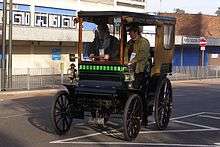
- Delahaye 134 - 1933-40
- Delahaye 135 - 1935-54
- Delahaye 138
- Delahaye 148
- Delahaye 168 - 1938-40
- Delahaye 175 - 1948-51
- Delahaye 178
- Delahaye 180
- Delahaye 235 - 1951-54
Picture gallery
- Engine Delahaye Type 32L Limousine 1912
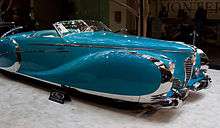 Delahaye 175S Roadster (1949) with coachwork by Saoutchik
Delahaye 175S Roadster (1949) with coachwork by Saoutchik%2C_D._v._d._Lof.jpg) Delahaye 135 MS (1936)
Delahaye 135 MS (1936)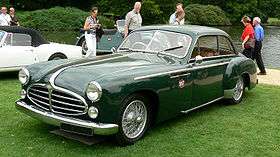 Delahaye 235MS Coupé (1953)
Delahaye 235MS Coupé (1953) Delahaye 135 (1948)
Delahaye 135 (1948)
 Delahaye 165 Figoni et Falaschi (1939)
Delahaye 165 Figoni et Falaschi (1939)- Delahaye Cabriolet (1937)
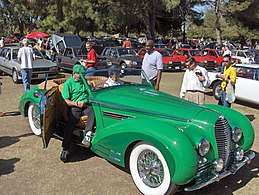 Delahaye 135
Delahaye 135 Delahaye 135 Cabriolet Pourtout
Delahaye 135 Cabriolet Pourtout
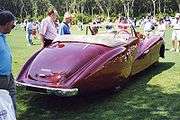 Delahaye 135 M Pourtout (1948)
Delahaye 135 M Pourtout (1948) Delahaye Tourer (1925)
Delahaye Tourer (1925) Delahaye 135M
Delahaye 135M Delahaye 135MS Roadster
Delahaye 135MS Roadster Delahaye 235M Saoutchik (1953)
Delahaye 235M Saoutchik (1953)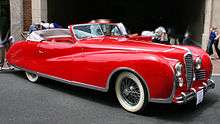 Delahaye 178 Drophead Coupé (1949), once owned by Elton John
Delahaye 178 Drophead Coupé (1949), once owned by Elton John
References
- "Bonhams : c.1906 Delahaye 10/12 CV Type 28 Roi-des-Belges 2062". www.bonhams.com. Retrieved 2016-11-03.
- Hull, Peter. "Delahaye: Famous on Road and Race Track", in Ward, Ian, executive editor. World of Automobiles (London: Orbis, 1974), Volume 5, p.521.
- Hull, p.521.
- Hull, p.521 caption.
- Hull, p.522.
- Hull, p.523.
- Hull, p.522 caption.
- Hull, p.524.
- Hull, p.523 caption.
- "Automobilia". Toutes les voitures françaises 1948 (salon Paris oct 1947). Paris: Histoire & collections. Nr. 7: 26. 1998.
- "Automobilia". Toutes les voitures françaises 1953 (salon Paris oct 1952). Paris: Histoire & collections. Nr. 19: 23. 2000.
- "Automobilia". Toutes les voitures françaises 1954 (salon [Oct] 1953). Paris: Histoire & collections. Nr. 24: 24. 2002.
- Delahaye - La belle carrosserie française. Jean-Paul Tissot. 2006. ISBN 978-2-7268-8697-7
External links
| Wikimedia Commons has media related to Automobiles Delahaye. |
- Delahaye Flickr Group
- Club Delahaye
- 1949 Delahaye Roadster belonging to Diana Dors (BBC)
- December 1937 - Motorsport Magazine - A fine French Sports car: a test in difficult conditions of the 3-Litre Delahaye
- Scan of the article which appeared in December 1937 in the Motorsport Magazine
- Delahaye - La belle carrosserie française